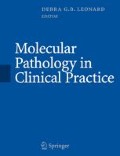Abstract
Osteogenesis imperfecta (OI) is a clinically heterogeneous disorder resulting from the reduced synthesis or the accumulation of abnormal type I collagen, which is a major structural component of many connective tissues including bone. Type I collagen is a trimeric molecule composed of two α1(I) chains and one α2(I) chain, encoded by the COL1A1 and COL1A2 genes, respectively. Fibrillar collagens have a long triple helical domain composed of Gly-X-Y repeats. Glycine residues at every third position are required for the formation of the triple helical domain.1 OI is predominantly inherited in an autosomal dominant fashion and is caused by a wide variety of mutational events in either the COL1A1 or COL1A2 gene.
Access this chapter
Tax calculation will be finalised at checkout
Purchases are for personal use only
Preview
Unable to display preview. Download preview PDF.
References
Kielty CM, Grant ME. The collagen family: structure, assembly, and organization in the extracellular matrix. In: Royce PM, Steinmann B, eds. Connective Tissue and Its Heritable Disorders. 2nd ed. New York: Wiley-Liss; 2002:159–221.
Silence D. Osteogenesis imperfecta: an expanding panorama of variants. Clin Orthop. 1981;159:11–25.
Byers PH, Cole WG. Osteogenesis imperfecta. In: Royce PM, Steinmann B, eds. Connective Tissue and Its Heritable Disorders. 2nd ed. New York: Wiley-Liss; 2002:358–430.
Körkkö J, Ala-Kokko L, De Paepe AD, et al. Analysis of the COL1A1 and COL1A2 genes by PCR amplification and scanning by conformational-sensitive gel electrophoresis identifies only COL1A1 mutations in 15 patients with osteogenesis imperfecta type I: identification of common sequences of null allele mutations. Am J Hum Genet. 1998;62:98–110.
Bruckner-Tuderman L. Epidermolysis bullosa. In: Royce PM, Steinmann B, eds. Connective Tissue and Its Heritable Disorders. 2nd ed. New York: Wiley-Liss; 2002:687–725.
Pulkkinen L, Uitto J. Mutational analysis and molecular genetics of epidermolysis bullosa. Matrix Biol. 1999;18:29–42.
Uitto J, Pulkkinen L. Molecular genetics of heritable blistering disorders. Arch Dermatol. 2001;137:1458–1462.
Cserhalmi-Friedman PB, Tang Y, Adler A, et al. Preimplantation genetic testing in two families at risk for recurrence of Herlitz junctional epidermalolysis bullosa. Exp Dermatol. 2000;9:290–297.
Steinmann B, Royce PM, Superti-Furga A. The Ehlers-Danlos syndrome. In: Royce PM, Steinmann B, eds. Connective Tissue and Its Heritable Disorders. 2nd ed. New York: Wiley-Liss; 2002:431–523.
Schalkwijk J, Zweers MC, Steijlen PM, et al. A recessive form of the Ehlers-Danlos syndrome caused by tenascin-X deficiency. N Engl J Med. 2001;345:1167–1175.
Schwarze U, Atkinson M, Hoffman GG, et al. Null alleles of the COL5A1 gene of type V collagen are a cause of the classic forms of Ehlers-Danlos syndrome (types I and II). Am J Hum Genet. 2000;66:1757–1765.
Pepin M, Schwarze U, Superti-Furga A, et al. Clinical and genetic features of Ehlers-Danlos syndrome type IV, the vascular type. N Engl J Med. 2000;342:673–680.
Pepin MG, Byers PH. Ehlers-Danlos syndrome, vascular type. GeneReviews [database online]. 1999. Available at: http://www.genetests.org. Updated 2002.
Schwarze U, Goldstein JA, Byers PH. Splicing defects in the COL3A1 gene: marked preference for 5′ (donor) splice-site mutations in patients with exon-skipping mutations and Ehlers-Danlos syndrome type IV. Am J Hum Genet. 1997;61:1276–1278.
Schwarze U, Schievink WI, Petty E, et al. Haploinsufficiency for one COL3A1 allele of type III procollagen results in a phenotype similar to the vascular form of Ehlers-Danlos syndrome type IV. Am J Hum Genet. 2001;69:989–1001.
Hyland J, Ala-Kokko L, Royce P, et al. A homozygous stop codon in the lysyl hydroxylase gene in a family with Ehlers-Danlos syndrome type VI. Nat Genet. 1992;2:228–231.
Yeowell HN, Walker LC. Mutations in the lysyl hydroxylase 1 gene that result in enzyme deficiency and the clinical phenotype of Ehlers-Danlos syndrome type VI. Mol Genet Metab. 2000;71:212–224.
Byers PH, Duvic M, Atkinson M. Ehlers-Danlos syndrome typeVIIA and type VIIB result from splice-junction mutations or genomic deletions that involve exon 6 in the COL1A1 and COL1A2 genes of type I collagen. Am J Med Genet. 1997;72:94–105.
Horton WA, Hecht JT. Chondrodysplasias: disorders of cartilage matrix proteins. In: Royce PM, Steinmann B, eds. Connective Tissue and Its Heritable Disorders. 2nd ed. New York: Wiley-Liss; 2002:909–937.
Superti-Furga A. Skeletal dysplasias related to defects in sulfate metabolism. In: Royce PM, Steinmann B, eds. Connective Tissue and Its Heritable Disorders. 2nd ed. New York: Wiley-Liss; 2002:939–960.
Rossi A, Superti-Furga A. Mutations in the diastrophic sulfate transporter (DTDST) gene (SLC26A2): 22 novel mutations, mutation review, associated skeletal phenotypes, and diagnostic relevance. Hum Mutat. 2001;17:159–171.
Körkkö J, Kaitila I, Lönnqvist L, et al. Sensitivity of conformational sensitive gel electrophoresis in detecting mutations in Marfan-syndrome and related conditions. J Med Genet. 2002;39:34–41.
Pyeritz RE, Dietz HC. Marfan syndrome and other microfibrillar disorders. In: Royce PM, Steinmann B, eds. Connective Tissue and Its Heritable Disorders. 2nd ed. New York: Wiley-Liss; 2002:585–626.
De Paepe A, Devereux RB, Dietz HC, et al. Revised diagnostic criteria for the Marfan syndrome. Am J Hum Genet. 1996;62:417–426.
Milewicz DM, Zsolt U, Boyd C. Genetic disorders of the elastic fiber system. Matrix Biol. 2000;19:471–480.
Handford PA, Downing AK, Reinhardt DP, et al. Fibrillin: from domain to supramolecular assembly. Matrix Biol. 2000;19:457–470.
Robinson PN, Booms P, katzke S, et al. Mutations of FBN1 and genotype-phenotype correlations in Marfan syndrome and related fibrillinopathies. Hum Mutat. 2002;20:153–161.
Katzke S, Booms P, Tiecke F, et al. TGGE screening of the entire FBN1 coding sequence in 126 individuals with Marfan syndrome and related fibrillinopathies. Hum Mutat. 2002;20:197–208.
Author information
Authors and Affiliations
Editor information
Editors and Affiliations
Rights and permissions
Copyright information
© 2007 Springer Science+Business Media, LLC
About this chapter
Cite this chapter
Hyland, J.C. (2007). Skin and Connective Tissue Disorders. In: Leonard, D.G.B., Bagg, A., Caliendo, A.M., Kaul, K.L., Van Deerlin, V.M. (eds) Molecular Pathology in Clinical Practice. Springer, New York, NY. https://doi.org/10.1007/978-0-387-33227-7_16
Download citation
DOI: https://doi.org/10.1007/978-0-387-33227-7_16
Publisher Name: Springer, New York, NY
Print ISBN: 978-0-387-33226-0
Online ISBN: 978-0-387-33227-7
eBook Packages: MedicineMedicine (R0)

